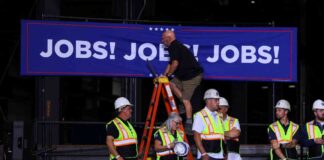In February, the U.S. job market seemingly maintained its momentum, with employers adding 151,000 jobs, according to a report from the Labor Department. This figure marked a notable increase, reflecting ongoing growth in the labor market. However, amid this apparent stability, there are underlying signs of potential fragility. Despite the positive job growth, the unemployment rate saw a slight uptick to 4.1%, with a shrinking workforce complicating the picture. Jobs were particularly abundant in sectors such as health care, construction, and manufacturing, yet the federal government saw a reduction of 10,000 positions. Interestingly, average wages in February showed a 4% rise from the previous year, demonstrating consistent wage growth outpacing inflation for nearly two years. Although the overall employment numbers may appear robust, a closer look reveals a more complex reality.
Federal Government Turmoil: A Closer Look at Layoff Trends
Beneath the surface of seemingly favorable job market statistics lies a troubling trend of increased layoffs, particularly in the federal government. According to Challenger, Gray & Christmas, an outplacement firm that tracks job cuts, more than 172,000 layoffs were announced in February alone, marking the highest monthly total since July 2020, during the early days of the pandemic. This surge in layoffs includes over 62,000 job cuts announced across 17 federal agencies. Andrew Challenger, the firm’s senior vice president, expressed surprise at the swift rise in layoffs this year, underscoring the significance of this unsettling development. Moreover, looming threats of further government job reductions, as the Trump administration seeks to drastically downsize the federal workforce, add to the prevailing uncertainty.
The Internal Revenue Service (IRS) and the Veterans Administration are reportedly contemplating substantial layoffs, potentially affecting tens of thousands of workers. Eddie Walker, a union representative for approximately 1,500 unionized IRS employees in Austin, Texas, described the emotional toll of the recent layoffs. As the tax collection agency shed over 6,000 jobs in February, mostly impacting probationary workers with less than a year of service, stories of personal hardship emerged. Walker shared poignant accounts of affected workers grappling with financial insecurity and emotional distress, painting a vivid picture of the human cost behind these job cuts.
Private Sector Challenges: Impact of Economic Uncertainty
While government layoffs have dominated headlines, the private sector is also grappling with significant challenges, exacerbated by economic uncertainty. Andrew Challenger highlighted the pervasive sense of unpredictability in various industries, attributing it to factors such as tariffs and potential trade wars. Notably, several large Fortune 500 companies have announced substantial layoffs and revised growth forecasts, signaling a broader trend of retrenchment. The ripple effects of these actions reverberate through the job market, influencing employment projections for the upcoming years.
In conclusion, the latest job market data, while appearing positive at first glance, reveals a more nuanced reality characterized by underlying instability and widespread layoffs. The juxtaposition of job gains in certain sectors with escalating layoff announcements underscores the intricate dynamics at play within the current economic landscape. As individuals and businesses navigate these uncertain times, the resilience of the labor market and the enduring impact of these developments remain subjects of ongoing scrutiny and analysis.






















